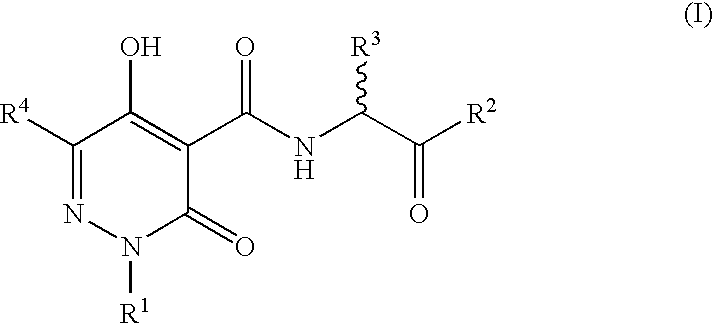N-Substituted Glycine Derivatives: Hydroxylase Inhibitors
a technology of hydroxylase inhibitors and glycine derivatives, which is applied in the direction of drug compositions, biocides, extracellular fluid disorders, etc., can solve the problems of reduced oxygen levels in the blood, ubiquitination of hif-alpha and subsequent degradation, and achieve the effect of increasing the production of epo
- Summary
- Abstract
- Description
- Claims
- Application Information
AI Technical Summary
Benefits of technology
Problems solved by technology
Method used
Image
Examples
example 1
[0109]
N-{[5-Hydroxy-6-methyl-3-oxo-2-(phenylmethyl)-2,3-dihydro-4-pyridazinyl]carbonyl}glycine
[0110]1a) Ethyl 3-[2-[2-(ethyloxy)-1-methyl-2-oxoethylidene]-1-(phenylmethyl)hydrazino]-3-oxopropanoate. Ethyl pyruvate (0.324 g, 2.79 mmol) was added to a stirred mixture of benzylhydrazine dihydrochloride (0.551 g, 2.82 mmol), diisopropylethylamine (1.00 mL, 5.74 mmol) and dichloromethane (10 mL). Magnesium sulfate (excess) was added and the mixture stirred 0.5 h, then loaded onto a short column of silica gel and the product eluted (50% ethyl acetate / hexane). After evaporation of the solvent, the crude hydrazone (0.339 g) was dissolved in tetrahydrofuran (20 mL) and sodium hydride (0.075 g of a 60% oil suspension, 1.88 mmol) added with stirring. The mixture was stirred 20 min, then ethyl 3-chloro-3-oxopropionate (0.235 mL, 1.84 mmol) injected dropwise and stirring continued at room temperature 10 min and at 60° C. for 0.5 h. Further sodium hydride (0.075 g of a 60% oil suspension, 1.88 mm...
example 2
[0113]
N-{[5-Hydroxy-3-oxo-6-phenyl-2-(phenylmethyl)-2,3-dihydro-4-pyridazinyl]carbonyl}glycine
[0114]2a) Ethyl 3-[2-[2-(ethyloxy)-2-oxo-1-phenylethylidene]-1-(phenylmethyl)hydrazino]-3-oxopropanoate. A mixture of ethyl oxo(phenyl)acetate (0.315 g, 1.77 mmol), benzylhydrazine dihydrochloride (0.334 g, 1.71 mmol), diisopropylethylamine (0.596 mL, 3.42 mmol), dichloromethane (10 mL) and excess magnesium sulfate was stirred for 18 h, then filtered through a plug of silica gel and the cake washed with 50% ethyl acetate / hexane. The solvent was removed under reduced pressure and the crude hydrazone dissolved in tetrahydrofuran (5 mL) and placed under nitrogen. 1,8-Diazabicyclo[5.4.0]undec-7-ene (0.212 mL, 1.42 mmol) was added, followed by ethyl 3-chloro-3-oxopropionate (0.182 mL, 1.42 mmol) dropwise. The mixture was stirred at room temperature for 2 h, then poured into water (50 mL) and extracted with ethyl acetate. The extracts were dried (MgSO4), evaporated under reduced pressure and the ...
example 3
[0117]
N-{[5-Hydroxy-6-(1-methylethyl)-3-oxo-2-(phenylmethyl)-2,3-dihydro-4-pyridazinyl]carbonyl}glycine
[0118]3a) Ethyl 3-oxo-3-[1-(phenylmethyl)hydrazino]propanoate. A mixture of benzylhydrazine dihydrochloride (2.50 g, 12.8 mmol), potassium carbonate (1.77 g, 12.8 mmol), acetone (6.0 mL, 82 mmol) and ethyl acetate (30 mL) was stirred at room temperature while a solution of 1M aqueous sodium hydroxide (6.0 mL, 6.0 mmol) was added dropwise. After the addition, the mixture was stirred 0.5 h, then excess magnesium sulfate added and the mixture filtered. The filtrate was evaporated under reduced pressure and the residue azeotroped with toluene three times, then dissolved in tetrahydrofuran (50 mL). 1,8-Diazabicyclo[5.4.0]undec-7-ene (1.84 mL, 12.3 mmol) was added to the stirred solution under nitrogen at 0° C., followed by ethyl 3-chloro-3-oxopropionate (1.57 mL, 12.3 mmol) dropwise. The mixture was stirred at 0° C. for 5 min, and at room temperature for 3 h, then 1M aqueous hydrochlori...
PUM
 Login to View More
Login to View More Abstract
Description
Claims
Application Information
 Login to View More
Login to View More - R&D
- Intellectual Property
- Life Sciences
- Materials
- Tech Scout
- Unparalleled Data Quality
- Higher Quality Content
- 60% Fewer Hallucinations
Browse by: Latest US Patents, China's latest patents, Technical Efficacy Thesaurus, Application Domain, Technology Topic, Popular Technical Reports.
© 2025 PatSnap. All rights reserved.Legal|Privacy policy|Modern Slavery Act Transparency Statement|Sitemap|About US| Contact US: help@patsnap.com



